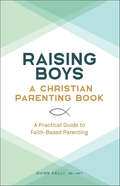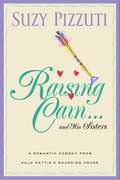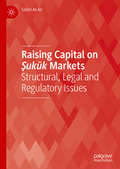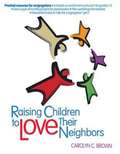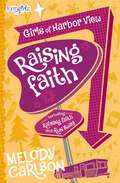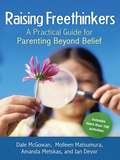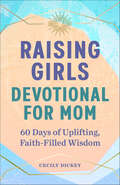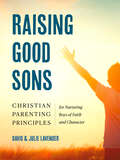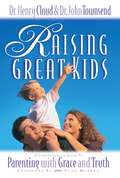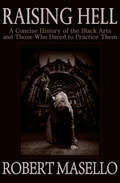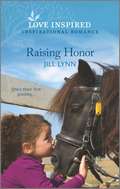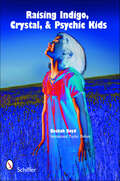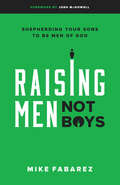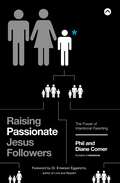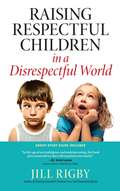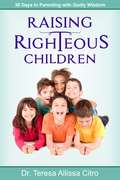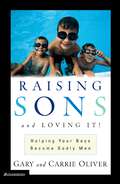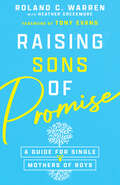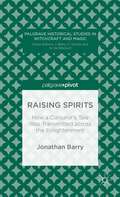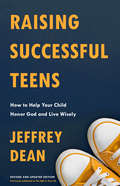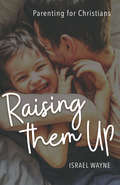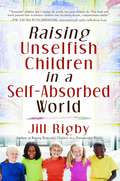- Table View
- List View
Raising Boys: A Practical Guide to Faith-Based Parenting (Raising Girls: A Christian Parenting Book)
by Quinn KellyWeave the Bible's wisdom into your parenting and instill faith in your son As a parent, you will always be your son's first and most powerful influence—which is why it's so important to raise him with God by your side. This guide is full of practical parenting advice and spiritual insights that show you how to root your parenting in God's Word and raise your son with intention and care.What sets this guide apart from other Christian parenting books:The basics of raising boys—Discover how your son's emotional and physical development impact your parenting style, and define the values and goals that keep him close to Christ.Parenting principles—Explore Bible-based principles that help you model your faith, set and respect boundaries, and create the foundation for a relationship based on love, trust, and understanding.Targeted techniques—Learn specific strategies for affirming your son's self-worth, dealing with bullies, navigating social media, and more.Be the wise and Christ-honoring parent your son deserves with help from this modern, Scripture-based guide.
Raising Cain ... and His Sisters
by Suzy PizzutiYou've heard it said, "Be careful what you pray for." But it may also be a good idea to be careful who you ask to pray. Because when folks like Hattie Hopkins talk to God...anything can happen! Stuck in the semi-reclusive life she's built for herself, Olivia Harmon is still recovering from the tragic loss of her husband and daughter five years before. Though she loves her job at Vermont's department of tourism, she longs for something more-so she asks her landlady Hattie to pray for a little volunteer work for her to do.Things don't work out exactly as she had planned, however, and soon Olivia finds herself bursting out of her carefully built cocoon to undertake the nurturing of three rambunctious street children. Even her heart seems out of control, causing her to fall for Zach Springer, the handsome handyman who rode a mudslide right into her sun room. Can a woman so accustomed to self-imposed solitude adjust to a new life, a new love, and the new challenge of Raising Cain...and His Sisters?From the Trade Paperback edition.
Raising Capital on Ṣukūk Markets: Structural, Legal and Regulatory Issues
by Salim Al-AliṢukūk markets have grown significantly worldwide since their emergence— in Islamic jurisdictions as well as conventional jurisdictions including the US, the UK, Germany, China, France and Singapore. The practices of ṣukūk markets, however, have come under close scrutiny. The legal and regulatory risks arising from the existing general legal environment and their impact on those investing and trading in ṣukūk markets has not received adequate attention. The topic of ṣukūk has been subject to extensive research and academic discussion from different perspectives, but the existing literature has not adequately addressed the issues associated with these markets. This book examines the contemporary issues encountered in the foundation and operation of ṣukūk markets by providing an in-depth discussion of the issues facing ṣukūk markets from legal and regulatory perspectives and focusing attention on how soundness can be ensured in the wider context. These issues go to the heart of what the ṣukūk market is really about, as recent debate has recognised in ṣukūk the replication of conventional bonds in ways that are considered unsatisfactory from an Islamic law point of view.
Raising Children To Love Their Neighbors: Practical Resources for Congregations
by Carolyn C. BrownRead the IntroductionDoes your congregation want to raise more mission-minded children? Here are practical plans with reproducible activities and outlines for classroom and service experiences for children ages 3 to 12.Carolyn Brown offers great “how to” plans that churches can build into their current programs. She includes : a hands-on enrichment curriculum for grades 1-5; over a year of monthly service projects for preschoolers; mini-workshops for teachers; and newsletters blurbs about the program."Carolyn Brown has written a 'must read' book for all parents and teachers. I know of no other book that presents so clearly, helpfully, and persuasively Jesus’ mandate to raise children to “love our neighbors as ourselves.” More than a mandate, it offers dozens of doable, practical suggestions for each age group and grade level. I will recommend this book to every teacher and parent in my church."--Rev. Dr. Donald L. Griggs, author of Teaching Today's Teacher to Teach published by Abingdon Press (item #9780687049547)From the Circuit Rider review: "Teachers, parents, Sunday school teachers, and church preschool teachers are all very familiar with the importance of teaching children to share, to take turns, to say “please” and “thank you,” and to not hurt others’ feelings. Veteran Christian educator Carolyn Brown puts this important formation into the larger context of the mission of the church. How do our children grow in compassion? How can we lead them to leave the world better than they found it? How do we raise mission-minded children?" (Click here to read the entire review.)
Raising Faith (Faithgirlz / Girls of 622 Harbor View #No. 5)
by Melody CarlsonBook 5, Project: Raising Faith: When the girls set out to raise the money to go on a 3-day ski trip with the church youth group, Morgan is confident that God will provide the funds. But while everyone else finds a way to afford the trip, Morgan’s plans are derailed by her grandmother’s illness, school, Christmas activities, even jealousy … and when Grandma suffers a heart attack, Morgan’s faith is severely tested. Will God provide what’s really important? The girls of 622 Harbor View may not have much, but they’ve got dreams, a desire to make the world a better place, and friendship. Book 6, Project: Run Away: The miraculous power of prayer—to protect, guide, and heal—plays an important role in the sixth adventure of the Girls of 622 Harbor View. Fleeing her abusive ex-husband, Emily’s mother packs up her two children and disappears down a rainy Oregon highway. Emily’s friends are devastated—they haven’t even been on the ski trip yet!—and they’re worried. But what can they do?
Raising Freethinkers: A Practical Guide for Parenting Beyond Belief
by Dale Mcgowan Molleen Matsumura Amanda Metskas Jan DevorAs a freethinking parent, you face a unique set of challenges in raising children without religious guidance. How will you help them understand issues like death, sexuality, morality, and religion itself, all while encouraging them to think for themselves?
Raising Girls: 60 Days of Uplifting, Faith-Filled Wisdom
by Cecily DickeyFind strength and guidance in God's wisdom as you raise your daughter Raising a daughter is an immense blessing, but it can be challenging at times. This devotional will inspire you, draw you closer to God, and give you confidence and encouragement as you go about the incredibly important job of helping your daughter be the best person she can be.What sets this book about raising girls apart from other mom devotionals:Support your daughter—Spend 60 days learning from Scripture and exploring the challenges that girls face so you can help your daughter succeed and thrive.Feel uplifted as a mom—Find reassurance that you're doing a great job, and that God is always there to guide you, as you encourage your daughter to recognize her worth and build a foundation of faith.Lean into the Lord—These devotions are meant to breathe life into a weary mother's heart whenever it's needed. Whether your daughter is a toddler or on the cusp of adulthood, it's always a good time to soak in the truth and encouragement of Scripture.Release your worries to the Lord and forge a stronger bond with your daughter using Raising Girls: A 60-Day Devotional for Moms.
Raising Good Sons: Christian Parenting Principles for Nurturing Boys of Faith and Character
by David Lavender Julie LavenderThe essential gospel-led parenting book for raising good sonsIn a world filled with countless parenting books and ever-changing advice, Christian parents often seek a single, unwavering source of guidance: God&’s Word. In Raising Good Sons, readers will learn how to lean on God while raising boys who are not only resilient and morally grounded but also deeply rooted in their faith. With heartfelt encouragement and scriptural wisdom, this book will become your trusted companion, reminding you that with God you are never lost or alone in your parenting journey.Raising Good Sons features:Essential Christian parenting principles that keep you grounded and anchored as you raise your son no matter what stage you&’re in.Relevant topics and issues that all parents of sons are navigating, such as building a personal relationship with Jesus, modeling godly behavior, learning respect, showing love, and much more.Biblical lessons in action that can be applied right away.Inspiring and supportive prayers that remind parents to keep God at the center.
Raising Great Kids: A Comprehensive Guide to Parenting with Grace and Truth
by Henry Cloud Elisa Morgan John TownsendWhat does it take to raise great kids? If you've read any books on parenting, conflicting opinions have probably left you feeling confused. Get tough! Show acceptance. Lay down the rules. Lighten up, already! There's got to be a balance between control and permissiveness. And there is. Drawing on the expert insights of counselors and award-winning authors Henry Cloud and John Townsend and on the parenting wisdom of MOPS (Mothers of Preschoolers) International, Raising Great Kids shows you that truth and grace aren't polar opposites. They are allies in your most challenging and rewarding task: raising children with character that can withstand life's rigors and make the most of its potential.
Raising Hell: A Concise History of the Black Arts and Those Who Dared to Practice Them
by Robert MaselloAn occultism reference chronicling the quest for metaphysical truth, from astronomers to astrologers, necromancers to sorcerers, alchemists to prophets. If the history of black magic and the occult reveals anything, it&’s that the drive to marshal the unseen powers of the dark, and bend them to mortal will, is as old as mankind itself. Men and women have believed, in virtually every age and in every land, that there is another world—a world of spirits and souls, angels and demons, gods and monsters, a world that might hold the answers to the great mysteries: What is the meaning of life? Do humans decide their own fate? Is there a Heaven? And, perhaps more important, is there a Hell? As they sought the answers to these questions, the occult pioneers often stumbled upon real and verifiable truths. Here, in one spellbinding volume, is a history of the major occult arts—necromancy, sorcery, astrology, alchemy, and prophecy—as they have been practiced from ancient Babylon to the present day. Raising Hell weaves history with mythology, quotes, anecdotes, and illustrations to provide a vivid chronicle of the evolution of the occult arts. From the origins of the pentagram and the sacred circle, to the incantations of necromancers, to the prophecies of Nostradamus, this definitive source offers a compelling look at the black arts and those who risked their lives—and some say their souls—to explore them.
Raising Hell: An Encyclopedia of Devil Worship and Satanic Crime
by Michael NewtonA chilling journey through the secret world of cults and covens, where innocent blood is shed for the glory of Satan.
Raising Honor (Colorado Grooms #5)
by Jill LynnDiscover this heartfelt romance by Jill Lynn, part of the uplifting Colorado Grooms series. She’s their first priority… Could a shared love for little Honor unite their reluctant hearts?Nothing will stop Ryker Hayes from giving his neglected five-year-old niece the stable home he never had. But to gain custody, he must move to Colorado…and prove to Honor’s wary foster mother, Charlie Brightwood, he’s more than just responsible. As his visits with Honor and Charlie begin to feel more like family time, might Charlie become another reason to stick around for good? From Love Inspired: Uplifting stories of faith, forgiveness, and hope.Colorado Grooms:Book 1: The Rancher’s Surprise DaughterBook 2: The Rancher’s Unexpected BabyBook 3: The Bull Rider’s Secret Book 4: Her Hidden Hope Book 5: Raising Honor
Raising Indigo, Crystal, & Psychic Kids
by Beckah BoydGifted children are prevalent in our society today, and many are part of intuitive groups that include Indigo, Crystal, and psychic children. Determine what types of gifts your child has among the three types. Understand what these children see and feel, and learn how to enhance and work with their abilities. Gain methods to teach them to use their skills to best advantage. Exercises address kids of all ages and learning types, and help you understand the mystery of psychic ability and its connection to your child. With an easy-to-understand format and simple exercises, learn not only help to strengthen your bond with your child, but to open your own sensitivities as well.
Raising Men, Not Boys: Shepherding Your Sons to be Men of God
by Mike FabarezHow to raise a godly man in a godless world Perhaps there has never been a more challenging time to raise children than in today&’s culture. Parents are having to address challenges that their parents never had to with them. And while the core elements to raising children are the same, parents need wisdom for applying them to this day and age. That&’s what this book is about: navigating the times and raising a generation of men on godly principles—sons who are ready, able, and motivated to represent God during their days of sojourning on this earth. Pastor and author Mike Fabarez will help parents pass the faith on to their sons, in prayer that the promises of God extend to the third and fourth generations… and beyond.Parents will be equipped to: Envision their son&’s future every daySet his spiritual trajectory Build a home that grows godly menAddress the rebellion in their son&’s heartPrepare him to face the world and contribute to itHelp their son toward a right view of play and leisure Navigate the teenage years There is an epidemic of grown men with the maturity of young boys. Be a parent who saves your child from prolonged adolescence. Scripture says, &“The father of the righteous will greatly rejoice; he who fathers a wise son will be glad in him&” (Prov. 23:24). Children are a gift from the Lord. Read Raising Men, Not Boys to steward the gift of parenting and shepherd your sons to be men of God.
Raising Men, Not Boys: Shepherding Your Sons to be Men of God
by Mike FabarezHow to raise a godly man in a godless world Perhaps there has never been a more challenging time to raise children than in today&’s culture. Parents are having to address challenges that their parents never had to with them. And while the core elements to raising children are the same, parents need wisdom for applying them to this day and age. That&’s what this book is about: navigating the times and raising a generation of men on godly principles—sons who are ready, able, and motivated to represent God during their days of sojourning on this earth. Pastor and author Mike Fabarez will help parents pass the faith on to their sons, in prayer that the promises of God extend to the third and fourth generations… and beyond.Parents will be equipped to: Envision their son&’s future every daySet his spiritual trajectory Build a home that grows godly menAddress the rebellion in their son&’s heartPrepare him to face the world and contribute to itHelp their son toward a right view of play and leisure Navigate the teenage years There is an epidemic of grown men with the maturity of young boys. Be a parent who saves your child from prolonged adolescence. Scripture says, &“The father of the righteous will greatly rejoice; he who fathers a wise son will be glad in him&” (Prov. 23:24). Children are a gift from the Lord. Read Raising Men, Not Boys to steward the gift of parenting and shepherd your sons to be men of God.
Raising Passionate Jesus Followers: The Power of Intentional Parenting
by Diane Comer Phil ComerHope and practical help for parents whose greatest longing is to shepherd their children into a vibrant faith in God.For Christian parents, there is no greater joy than seeing their children learn to walk with the Lord. And there is no greater fear than that their children will walk away from God.After serving together in pastoral ministry and raising their now-grown children, Phil and Diane Comer know those hopes and fears well. Like all new parents, they were intimidated and unsure about how to take on the task of spiritually training their young children. But now, with all four of their children grown and establishing their own households of faith, Phil and Diane have embarked on a quest to help the next generation of parents raise passionate Jesus followers.Drawing on years of pastoral counseling, teaching, leading, and decades of watching families from the perspective of pastors and leaders in ministry, Phil and Diane instruct, guide, encourage, and offer hope and practical help to Christian parents.Raising Passionate Jesus Followers is a manual full of practical, biblically based, and time-tested guidelines that parents will be able to turn to again and again through every stage of their children's development, including . . .Formulating a planLaying the foundation, ages 0-5Doing the framing, ages 6-12Installing the functional systems, ages 13-17Completing the finish work, ages 18-22And keeping the front door open for your grown children
Raising Respectful Children in a Disrespectful World
by Jill RigbyThis inspirational parenting guide offers proactive and positive steps to raising respectful, engaged, and grateful children. In an effort to raise children with a healthy view of themselves, parents often focus on self-esteem rather than self-respect. And author Jill Rigby says there’s a big difference. It’s the difference between self-centered and others-centered children, the difference between performance-driven and purpose-focused teenagers. Raising Respectful Children in a Disrespectful World examines three different styles of parenting—parent-centered, child-centered, and character-centered. Parent-centered parents are more concerned with their own agenda than their child’s best interest. Child-centered parents are more concerned with their child’s approval than their child’s well-being. Character-centered parents are more concerned with their child’s character than their child’s comfort. Drawing a distinction between performance and purpose, this book maintains that rather than focusing on what you want your child to do, you ask what you want your child to become. Finally, Rigby calls for parents to discipline (teach) their children rather than punish them. With wisdom and insight, Jill Rigby shares age-appropriate ways to set boundaries with children without building walls of separation. Whether you’re parenting tots or teens, Raising Respectful Children in a Disrespectful World offers valuable advice for cultivating a house of respect.
Raising Respectful Children in a Disrespectful World
by Jill RigbyAuthor and speaker Jill Rigby maintains that our society has substituted self-esteem for self-respect, and in the process, we've lost our manners. In this inspirational and practical book, she tells parents how to instill character and purpose in their children without erecting walls of rebellion. In an effort to raise children with a healthy view of themselves, parents have focused on self-esteem rather than self-respect. And author Jill Rigby says there's a big difference. It's the difference between self-centered and others-centered children, the difference between performance-driven and purpose-focused teenagers.This book also examines three different styles of parenting--parent-centered, child-centered and character-centered. Parent-centered parents are more concerned with their own agenda than their child's best interest. Child-centered parents are more concerned with their child's approval than their child's well-being. Character-centered parents are more concerned with their child's character than their child's comfort. A chapter on the School of Respect gives guidance for tots to teens and what the goal for each age group is and what training is necessary to reach that goal. This chapter also includes thirty-six ways to cultivate a house of respect. Drawing a distinction between performance and purpose, this book maintains that rather than asking what you want your child to do, you ask what you want your child to become. In delineating the difference between being a coach to your child vs being a cheerleader, the author teaches parents the difference in offering false and genuine praise and applauding mediocrity vs engendering excellence. With wisdom and insight, Jill Rigby shares age-appropriate ways to set boundaries with children without building walls of separation. Finally, she calls for parents to discipline (teach) their children rather than punish them.
Raising Righteous Children: 30 Days to Parenting with Godly Wisdom
by Teressa Allissa CitroThirty Days of Wisdom, Encouragement, and Prayer for Christian Parents Raising Honorable and Pure-Hearted Young Men and WomenTeaching children how to live godly lives in a world geared toward selfishness is beyond difficult. Moral character, self-respect, respect for peers, respect for authority, the sanctity of life, purity, and honoring God in all things, are the character traits of a righteous child.Through real-life examples and practical application, Dr. Citro shows parents how to instill Godly-character, confidence, and success from birth to adulthood. In this easy-to-read and easy-to-understand thirty-day devotional, Dr. Citro uses personal examples of challenging situations, taboo topics, and biblical ways to handle each.Each daily devotion includes teaching surrounding a specific issue, a practical example of the topic, along with a parental prayer for spiritual power and dominion. Dr. Citro explains how to effectively put the Armor of God on our children while personally living a life of holiness and righteousness.“Grandchildren are the crown of grandparents, and parents are the glory of their children.” PROVERBS 17:6About the AuthorAn accomplished author and public speaker in the field of Education and Special Education, Dr. Teresa Citro has received many awards for her contributions in the field of Special Education Worldwide.Dr. Citro is the Chief Executive Officer of Learning Disabilities Worldwide Inc. and the Founder and President of Thread of Hope Inc. Additionally, she is the Founder and Chief Executive Officer of Citro Cosmetics and Skin Care, and the Founder and Chief Executive Officer of Citro Collection Fine Jewelry. Dr. Citro is Editor and Chief of Everyday Life Magazine and the Co-Editor of two peer-reviewed journals on Special Education.She resides in Boston, Massachusetts, and is the mother of two children.
Raising Sons and Loving It!: Helping Your Boys Become Godly Men
by Carrie Oliver Gary OliverIn these days of daunting headlines, here's some really good news: Your son was God's idea, and you can help him weather the often rocky transition from boyhood to a manhood shaped by God's character and purposes. Drawing from their extensive clinical and personal experience, Gary and Carrie Oliver show you - How boys really are different from girls - Five keys to raising "emotionally intelligent" sons - What your boys need from your marriage -- and from you - How to help your sons cultivate a heart for God - How to cultivate your sons' ability to deal with failure, loss, and grief . . . And much more.
Raising Sons of Promise: A Guide for Single Mothers of Boys
by Roland C. WarrenMillions of single mothers find themselves in the difficult position of raising boys alone. Many of those boys are at risk of falling behind in school or repeating the patterns of their own absent or neglectful fathers. Single mothers, who are often the only parental influence on their sons, are critical to reversing this troubling trend. But how? You might be wounded by the broken promises of your child's father. But God offers a greater promise to you and your family. Roland Warren, himself the child of a single mother, invites single moms on a journey not only to heal their hearts but also to parent their boys to become healthy men, good husbands, and strong fathers. He offers guidance and wisdom to moms who want to raise sons who will make and keep their commitments. Drawing from the Genesis story of Hagar and Ishmael, Warren shares insights and stories of how mothers can find healing and hope for their sons to become better men of character and action.
Raising Spirits: How a Conjuror’s Tale Was Transmitted across the Enlightenment
by Jonathan BarryDespite supernatural scepticism, stories about spirits were regularly printed and shared throughout the 18th and 19th centuries. This case-study in the transmission of a single story (of a young gunsmith near Bristol conjuring spirits, leading to his early death) reveals both how and why successive generations found meaning in such accounts.
Raising Successful Teens: How to Help Your Child Honor God and Live Wisely
by Jeffrey DeanThis revised and updated edition of The Fight of Your Life features a new title, refreshed design, and 70% new content.From every side--the Internet, social media, interactions with friends, in both their public and private lives--teens are persuaded to follow the world's way over God's every day. Culture's mantra "live for today" has become the slogan of this generation! But, one thing remains true--mom and dad are still the greatest influence in the life of their child. Based on timeless biblical truths, Raising Successful Teens equips parents with positive, encouraging, and practical advice. A family and teen culture expert with more than 25 years of ministry experience, Jeffrey Dean gives parents the street-level approach they need to help their teens wisely and safely navigate technology, friendships, dating relationships, social media, and more. Parents will learn how to keep the lines of communication open and stay involved in their teens' lives.
Raising Them Up: Parenting for Christians
by Israel WayneMost parents want a book that will “fix their child” in three easy steps, in 30 days or less. While understandable, this expectation will never work. The problem lies far more with us, the parents, than it does with our child. If we don’t understand that truth, we will only remain frustrated and disappointed with our child. The far greater need is to fundamentally change our own hearts and minds as parents. As a principle, that simply MUST happen before any change will come for our youth. Christian parents may know a lot of Bible verses, yet don’t have a Biblical theology of parenting. Here’s the big picture: parenting is discipleship.Your child is learning from you. You are the teacher. Far more is caught than taught in parenting. Children listen to what you say, but they watch how you live. When you are slack in dealing with character issues in your own life, it short circuits your ability to effectively reach your child’s heart. In Raising Them Up, you will discover: A heart check for parents The world of “techno-parenting” How to teach purity Helping the difficult child Parenting by grace Home-based apologetics and more! It’s not about gimmicks…it’s about God – His inspired, inerrant, infallible, timeless truths. There are lots of other books out there that will teach you how to count to three, hold your breath, snap your wrist with a rubber band, and hand out stickers as a way to change your rebellious child. With enough tips, tricks, and methods, perhaps you can learn the perfect approach to timeouts or some magic cure that will solve bickering, sibling rivalry, laziness, back-talking, media addiction, lying, stealing, bad attitudes, apathy, angry outbursts, rebellion, inattention, or any other number of “fruits” that annoy, inconvenience, and embarrass us. But if you care enough to risk having to make changes in your own way of thinking and living, then let’s walk together on this path of learning to powerfully and prayerfully parent our children after the ways of God.
Raising Unselfish Children in a Self-Absorbed World
by Jill RigbyChild expert Jill Rigby reveals the dangers of the self-esteem parenting philosophy and offers an alternative approach that teaches children to respect both themselves and others. After decades of experimenting with child-focused parenting, parents are beginning to realize that the result is often self-centered children who tend toward narcissism, selfishness, mediocrity, and dysfunction. Rigby espouses a new goal of parenting: gently bumping children off self-center and teaching them to be unselfish givers instead. Raising Unselfish Children in a Self-Absorbed World dares to revisit the values of compassion, forgiveness, thanksgiving, and unselfishness and insists that we can instill these values in our children. With her encouraging approach, Rigby helps parents realize it's never too late to change their children's point of view and equip them to interact with kindness and respect in a world outside themselves. Teaching concepts, such as developing a passion for compassion, learning to give by forgiving, and filling every day with thanksgiving, Raising Unselfish Children in a Self-Absorbed World offers a new paradigm for parenting -- one that educates the heart and teaches moms and dads how to parent with a new end in mind.
